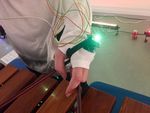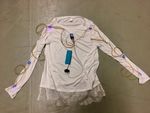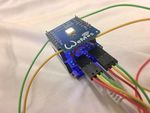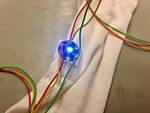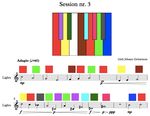Synesthetic: Composing works for Marimba and Automated Lighting - heim.ifi.uio.no
←
→
Page content transcription
If your browser does not render page correctly, please read the page content below
Synesthetic: Composing works for Marimba and
Automated Lighting
Christina Hopgood Charles P. Martin Gísli Jóhann Grétarsson
christina.hopgood@gmail.com Department of Informatics and gjgretarsson@gmail.com
RITMO
University of Oslo
charlepm@ifi.uio.no
ABSTRACT
This paper describes a series of explorations aimed at de-
veloping new modes of performance using percussion and
computer controlled lighting, linked by electronic sensing
technology. Music and colour are often imagined to be
related and parallels have been drawn between the colour
spectrum and keyboard. Some people experience a condi-
tion, chromesthesia (a type of synesthesia), where experi-
ences of colour and sound are linked in the brain. In our
work, we sought to explore such links and render them on
stage as part of a musical performance. Over the course
of this project, tools and strategies were developed to cre-
ate a performance work consisting of five short movements,
each emphasising a different interactive strategy between
the performer, lights, and composition. In this paper, we
describe the tools created to support this work: a custom Figure 1: The performer playing one of the works
wearable lighting and sensing system, and microcontroller in Synesthetic. The stage was dark except for com-
based OSC to DMX lighting controller. We discuss each puter controlled lighting on the rear wall and a
composition and how the interactions reflect ideas about wearable lighting system on the performer’s shirt.
synesthesia. A video of this performance can be found here:
https://vimeo.com/252963118/2c027dee67
Author Keywords
percussion, colour, synesthesia, composition, artistic research
lumières” (colour organ) by Alexander Scriabin in 1915 [9]
which projects light onto walls when its notes are played.
CCS Concepts In 1919, German film director Walter Ruttmann predicted
•Applied computing → Performing arts; Sound and that technological advances would increase the amount of
music computing; •Human-centered computing → Vi- connections between sound and images in art, resulting in a
sualization; “constant state of being swamped with material” [7]. While
this has not occurred, we have seen several modern attempts
1. INTRODUCTION at integrating sound and visual material, such as the inter-
active installation LINE, a three dimensional interface that
Music has long been associated with colour [9]. The word
emits sound and corresponding light [6].
“colour” is commonly used to describe multiple aspects of
This project, called Synesthetic, focused on chromesthe-
music–the tone quality, the mood of a piece, the type of in-
sia. The French composer Olivier Messiaen “suffered” from
strumentation. Artists often attempt to depict their experi-
chromesthesia, as Messiaen explained to the French critic
ence of music in their visual works [8]. Synesthesia is a neu-
Claude Samuel in 1988: “I see colours when I hear sounds,
rological condition in which stimuli trigger one or more sec-
but I don’t see colours with my eyes. I see colours intellec-
ondary senses in addition to usual sense. These experiences
tually, in my head.” [2]. While few synesthetes experience
can affect any sense, for example lexical-gustatory synes-
the same correlations between sound and colour, individuals
thesia where words stimulate taste responses [3]. Some in-
have consistent associations in their own experiences [10].
dividuals with synesthesia literally experience colours when
One synesthete has described his music-triggered colour ex-
they hear sounds; this is known as chromesthesia. Since
periences as having “... a sort of transparent, luminous bril-
this phenomenon became recognised it has been of interest
liance... like a screen before him” [10]. To imitate this ex-
to composers, leading to the development of a “clavier à
perience, we experimented with new modes of performance
and composition for percussion, coloured lights, and sens-
ing (shown in Figure 1). The senses of hearing and vision
are inextricably linked for synesthetes, and so we wished
to create a connection between sound and visuals that was
Licensed under a Creative Commons Attribution aesthetically pleasant and not jarring; a matching that was
4.0 International License (CC BY 4.0). Copyright complementary rather than just added-on.
remains with the author(s). For this project, we created a system where instead of au-
UNDER REVIEW, Not for Distribution tomatic projection of light when a key is pressed (as in theFigure 2: Our performance system included wear-
able and stage lighting, a motion sensor, and audio
tracking of the marimba sound.
colour organ), we used a Pure Data patch on a computer
to listen to the notes on an acoustic marimba, recognise Figure 3: Detail of our wearable lighting system in-
pitches and note onsets, and then respond appropriately stalled on the performer’s costume (top and bottom
with a coloured LED light. Percussion is a visually mo- left). Motion sensor attached to the performer’s
tivated discipline [11] with a distinctive gestural language. hand (bottom right).
With respect to this, we also used motion sensing to create a
connection between the movement of striking the marimba,
hand sewn to the shirt to accomodate the LEDs and mi-
sound and light.
crocontroller module. The lights were positioned at the
We created five interaction environments in which the
upper wrists, elbows, upper arms, shoulders, and one at-
lights would respond differently to the sound of the marimba
tached to the microcontroller in the centre of the chest. A
and the movement of the performer. Our composer wrote
USB battery to power the microcontroller was held in the
five short pieces that demonstrate and explore each inter-
performer’s pocket.
action. We developed this work during a five-day artistic
residency, creating one new interaction environment each 2.2 Movement Sensor
day, and a composition on each of the first four days. We
Another Wemos D1 Mini Lite was used as a wearable move-
performed these four pieces and one improvisation to a small
ment sensor. A small accelerometer breakout board (ADXL345),
audience who were able to give feedback after the perfor-
was attached to microcontroller, and this system attached
mance.
to the performer’s hand with velcro strips to sense percus-
sive gestures (see Figure 3). For our work, we experimented
2. SYSTEM DESIGN with using the accelerometer readings as well as the simple
In this section we describe the design of our performance “tap” gesture, recognised on the accelerometer chip, to drive
system. This consisted of wearable lights, sensors, and our aspects of the sound/light interactions.
computer controlled stage lighting system. These systems
were coordinated by a laptop running Pure Data, where we 2.3 Lighting Controller
were able to experiment with different interactions during For project development and our initial performance we
development. Our Pure Data program also ran pitch track- used a set of low-cost RGB LED lighting bars and devel-
ing and onset detection on the marimba sound, which was oped a custom solution for controlling them via their DMX
used for different interactions in our compositions. There interface. We were inspired by an Arduino-based lighting
were no electronic sounds in our project. A summary of our controller2 , which included a wired network connection for
system design in shown in Figure 2. Source code and parts input, DMX output, and a 3D-printed enclosure.
lists for our setup are available on our GitHub repository1 . For our project, we used a similar controller design, us-
ing an Arduino, Ethernet shield, and a MAX485 breakout
2.1 Wearable Lighting board for interfacing via DMX (see Figure 4). We devel-
Our wearable lights and sensors used Wemos D1 Mini Lite oped firmware for our use-case that could respond to OSC
systems, internet of things (IoT) prototyping boards based messages and used an edited version of the 3D-printed en-
on the Espressif ESP8285 microcontroller. These small and closure. In future, this controller could be replaced by a
inexpensive boards can be powered by a USB battery and more refined system that communicates over WiFi rather
include WiFi connectivity, and programming capabilities than wired ethernet.
similar to an Arduino microcontroller. This prototyping
platform is comparable to those used in previous research 2.4 Stage Setup
using the ESP8266 module [4] and XBee wireless system [1]. Our stage for the premiere performance was a large dance
The wearable lights included one Wemos D1 Mini on the studio with white walls. We positioned the marimba about
performer’s chest (see Figure 3) connected to nine RGB 1.5m away from a wall, facing into the centre of the room.
LED modules (WS2812 breakout boards a.k.a. “neopix- The lights were positioned on the floor so that they shone
els”). The LED modules were backed with velcro and could onto the wall behind the performer. The performer was able
be attached in various ways to the performer’s costume dur- to see some of the ambient light reflected on the marimba
ing our project development. The costume consisted of a in concert lighting conditions. Our computers were set up
plain white long-sleeved t-shirt, altered to have thumb holes to the side, out of the direct line of sight of the audience
to keep the sleeves more secure. Velcro loop squares were and performer. There was no additional stage lighting.
1 2
URL to source code repository to follow after review. https://github.com/alfo/artnetFigure 4: Our OSC to DMX lighting controller
(left) and our experimental stage lighting rig
(right).
Figure 6: An excerpt of the score for session 3 (not
shown to the performer), showing the notation as
well as the associated colour. Also shown is our
modified 12-tone colour association keyboard
a synesthete in the clinical sense [5], he felt strong connec-
Figure 5: An excerpt from the score of session 1 tions between colour and sound. Our attempts to replicate
showing the marimba jumping from the high range Scriabin’s mapping were frustrated by the colour reproduc-
to the low range of the marimba. tion ability of our LED stage lights; however, we were able
to find a set of twelve similar colours such that the contrast
3. COMPOSITION between each tone was discernible.
This composition is a twelve-tone work, where the tonal
After developing our wearable and stage lighting systems, material comes from the first 8 bars of the development sec-
we developed five compositional sketches for Synesthetic tion of the fourth part of W.A. Mozart’s Symphony No.40
during an intensive five-day workshop. Each of these sketches in G minor, K.550.
explored different interactions between lighting and sound
and featured contrasting compositional material. The fol-
lowing sections describe each of these works. 3.3 Communicating from Colour-Scale to Per-
former
3.1 Connecting Sound to Colour Sacks describes a synesthete who sees a pane of yellow glass
In the first session, our aim was to use a simple sound-to- and is reminded of the key of B flat major [10]. This in-
light interaction in a composition. We divided the colours dicates that synesthesia can go both ways—from music to
red, green and blue across the entire range of the marimba. colour and the reverse. For session three, we intended to use
We made the lowest pitch notes of the marimba trigger blue Scriabin’s colour-tone association from the previous session
lights, the middle ones green and the highest ones red. The in an inverse manner: to communicate instructions to the
colours blended when notes were played between these pure performer. We programmed a series of colours to illuminate
colours, blending red with green in the upper middle regis- the costume, to instruct the performer which note to play
ter and blending green with blue in the lower middle reg- using the 12-tone colour scale. This required the performer
ister. The composition written for this session utilised this to memorise the series of colours in the scale (see figure 6).
blending and changing of colours, which led to some unusual In practice, we found that it was almost impossible to dis-
jumps between very high and very low notes (see Figure 5). cern several of the colours when trying to “read” them in this
The lowest octave of the marimba has strong, clear over- way. In particular, the lights did not make clear greys or
tones, and we found that these led to misclassification in browns. We attempted to overcome this problem by chang-
our pitch tracking patch and caused the lights to flash be- ing several note colours to be more easily distinguishable.
tween red and blue. We attempted to eliminate this flashing It was necessary for the composition to be monophonic and
effect by adjusting the position of microphone and chang- slow to allow the performer to discern the colour, find the
ing to softer mallets. Softer mallets did produce more of correct note, and play.
the fundamental tone, but can be too soft to properly play To add an extra dimension to the challenge of this work,
the higher notes. In our performance, we compromised on the wearable lights were set to indicate the score to the
a medium-soft mallet which made the high notes audible performer, and the background lights react to show the ac-
when played with some force, and did not produce too many tual notes played. The audience watching could then tell
interfering overtones in the lower register. if the performer played a wrong note by seeing a difference
between the colour on the costume and the colour on the
3.2 Designing a Twelve-Tone Colour-Scale background wall. It was still very difficult for the performer
For this composition we focused on connecting the twelve to correctly discern some of the the notes based on the lights
tones of the keyboard to individual colours. Some have on the costume. For instance, blue and purple, and dark
attempted to assign each tone to a colour, matching fre- green and light green, were easily confused. This limita-
quencies to positions in the colour wheel, Well’s work is one tion could be due to the colour reproduction of our lighting
example [12]. However Wells’ proposal is not the experience setup and we hope that further experimentation with differ-
of most synesthetes. Instead of using this kind of ordered ent stage lights may lead to more reliable communication.
rainbow approach, our tone-to-colour mappings was bor- Despite the limitations of the setup in the performance, au-
rowed from Scriabin’s 1910 work Prometheus: The Poem of dience members enjoyed this piece due to the clear and visi-
Fire (Op. 60) where the score indicates how certain colours ble interaction between performer, composition, sound, and
should fill the stage. Although Scriabin was probably not light.timbre of the note. We feel that such interactions between
sound and light imitate what some synesthetes may experi-
ence when listening to music, although it was not possible
to provide a fully immersive experience with our limited
setup. While the connections we have made make artistic
sense, we suspect that it may be jarring for actual synes-
thetes to view our performance, as the projected lights may
not match their own experience of synesthesia. In future,
we aim to expand this project to a concert-length program
of composed music and lighting interactions, or expanding
the artistic goals by adding more musicians or a dancer.
Acknowledgements
Figure 7: An image from Session 4, where tonality This work was partially supported by Arts Council Norway,
was connected to colour. and the Research Council of Norway under funding agree-
ment 240862.
3.4 Indicating Tonality with Colour 5. REFERENCES
One synesthete has described seeing colours associated with [1] M. Baalman. Wireless sensing for artistic
keys, chords, and tonalities rather than individual notes [10]. applications, a reflection on sense/stage to motivate
The person had over 24 different colour associations with the design of the next stage. In Proc. Int. Conf.
the different keys and modes. To mirror this association, NIME, pages 307–312, 2017. URL: http://www.nime.
a composition was created that had several distinct key org/proceedings/2017/nime2017_paper0059.pdf.
changes throughout. During the performance of the piece,
[2] L. Ballard, M. Bengtson, and J. B. Young. The
a matching sequence of colours was displayed on the stage
alexander scriabin companion: History, performance,
lights at the key changes (see figure 7). This lighting change
and lore. Rowman & Littlefield Publishers, 2017.
was triggered manually by the composer. The lights on
the costume corresponded to the notes actually being per- [3] M. J. Banissy, C. Jonas, and R. C. Kadosh.
formed, using the tone-colour keyboard we designed in the Synesthesia: an introduction. Frontiers in Psychology,
previous session. Although this session was the simplest 5:1414, 2014. doi:10.3389/fpsyg.2014.01414.
in terms of interaction, feedback from audience members [4] S. Ferguson, A. Rowe, O. Bown, L. Birtles, and
suggested that they found this piece to be relaxing and in- C. Bennewith. Sound design for a system of 1000
teresting. distributed independent audio-visual devices. In Proc.
Int. Conf. NIME, pages 245–250, 2017. URL:
3.5 Connecting Motion to Light http://www.nime.org/proceedings/2017/nime2017_
paper0046.pdf.
Percussion can be defined by performance gestures, the mo-
tion of striking an object, rather than any particular in- [5] B. M. Galeyev and I. L. Vanechkina. Was scriabin a
strument [11]. In the fifth session we experimented with synesthete? Leonardo, 34(4):357–361, 2001.
connecting data from our motion sensor to light. We were doi:10.1162/00240940152549357.
able to develop a simple method for inferring strike ges- [6] D. Kobori, K. Kagawa, M. Iida, and C. Arakawa.
tures by detecting high aggregated acceleration of the per- Line: Interactive sound and light installation. In
former’s hand. We used such strike events to temporarily Proceedings of the International Conference on New
light up the performer’s costume with a white light which Interfaces for Musical Expression, pages 110–113,
subsequently faded to mirror the marimba’s sound envelope. 2006. URL: http://www.nime.org/proceedings/
This connection was quite compelling as the costume lights 2006/nime2006_110.pdf.
flashed in rhythm with the percussionist’s left hand. As [7] M. McDonnell. Visual music. Visual Music Marathon
this was the final session, a composition was not completed Program Catalog,, 2007.
in time to receive feedback at the open rehearsal evening. [8] A. McNamara. The colour of modernism:
Instead, a short improvisation was performed which ade- Colour-form experiments in europe and australia. In
quately demonstrated the interaction between movement S. Bru and P. Nicholls, editors, Europa! Europa? The
and light. Avant-Garde, Modernism and the Fate of a
Continent, volume 1 of European Avant-Garde and
Modernism Studies. De Gruyter, 2009.
4. CONCLUSIONS AND FUTURE WORK [9] K. Peacock. Instruments to perform color-music: Two
The aim of this project has been to explore real-time con- centuries of technological experimentations. Leonardo,
nections between sound and light in marimba performance, 21:397–406, 1988.
inspired by real and imagined concepts of “synesthesia”. In [10] O. Sacks. Musicophilia: Tales of music and the brain.
this paper, we have described our stage setup for exploring Knopf, New York, N.Y., 2007.
such connections, this includes wearable lighting and motion [11] S. Schick. The Percussionist’s Art: Same Bed,
sensing systems, a custom DMX lighting controller, and au- Different Dreams. University of Rochester Press,
dio analysis Pure Data patches. We have also described a Rochester, NY, USA, 2006.
series of five interactive environments using this setup, and
[12] A. Wells. Music and visual color: A proposed
compositions written to explore these environments. In the
correlation. Leonardo, 13(2):101–107, 1980.
first two sessions, it may have been more accurate to use a
doi:10.2307/1577978.
MIDI instrument to map the notes to certain lights and vice
versa; however, it could be that the confusing overtones of
the marimba and flashing effects is what a synesthete might
experience. We do hear those overtones, and they define theYou can also read




